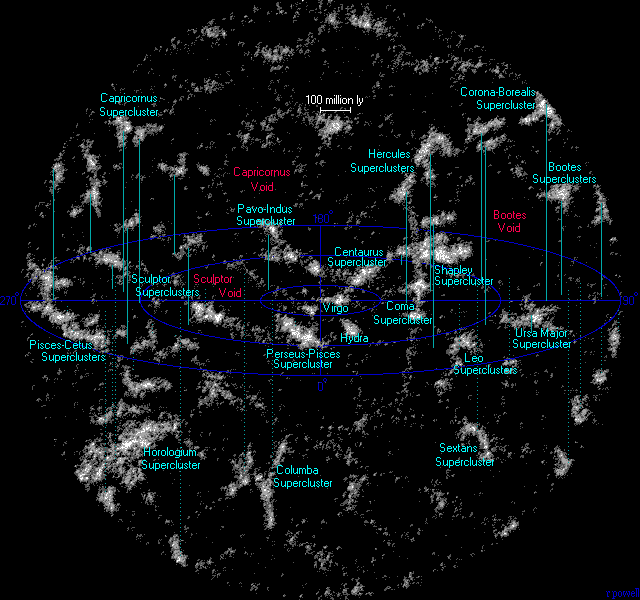Void (astronomy)
Appearance
In astronomy, voids are the empty spaces between filaments, the largest-scale structures in the Universe, that contain very few, or no, galaxies. Voids typically have a diameter of 11 to 150 Mpc; particularly large voids, defined by the absence of rich superclusters, are sometimes called supervoids. Voids located in high-density environments are smaller than voids situated in low-density spaces of the universe.[1]
List of voids
A 1994 census lists a total of 27 supervoids with a distance of up to 740 Mpc.[2]
| # | Name | Distance (h-1Mpc)[3] | Diameter (h-1Mpc)[4] |
|---|---|---|---|
| 1 | 134 | 88 | |
| 2 | 207 | 96 | |
| 3 | 216 | 72 | |
| 4 | 241 | 86 | |
| 5 | 129 | 92 | |
| 6 | 236 | 72 | |
| 7 | 248 | 100 | |
| 8 | 201 | 76 | |
| 9 | Southern Local Supervoid | 96 | 112 |
| 10 | 246 | 144 | |
| 11 | 160 | 92 | |
| 12 | 227 | 106 | |
| 13 | 246 | 94 | |
| 14 | 167 | 68 | |
| 15 | 241 | 98 | |
| 16 | 222 | 74 | |
| 17 | 216 | 94 | |
| 18 | 119 | 102 | |
| 19 | 119 | 108 | |
| 20 | Boötes void | 216 | 78 |
| 21 | 143 | 116 | |
| 22 | 246 | 96 | |
| 23 | 219 | 72 | |
| 24 | Northern Local Supervoid | 61 | 104 |
| 25 | 198 | 74 | |
| 26 | 246 | 80 | |
| 27 | 241 | 70 |
Not shown in the above chart:
- Capricornus Void
- The Eridanus Supervoid, reported on 24 August 2007 by the NRAO from Very Large Array Sky Survey data, is much larger than these, being about 300 h-1Mpc in diameter and 1800–3000 h-1 Mpc distant. It also corresponds to a cold spot in the cosmic microwave background. [5]
Maps

External links
- Universe family tree: Void
- a few animated views of voids and their distribution from Hume Feldman with Sergei Shandarin, Dept. Physics and Astronomy, University of Kansas, Lawrence, KS, USA.
References
- ^ U. Lindner, J. Einasto, M. Einasto, W. Freudling, K. Fricke, E. Tago (1995). The Structure of Supervoids I: Void Hierarchy in the Northern Local Supervoid "The structure of supervoids. I. Void hierarchy in the Northern Local Supervoid". Astron. Astrophys. 301: 329.
{{cite journal}}: Check|url=value (help)CS1 maint: multiple names: authors list (link) - ^ Einasto, M (1994-07-15), "The Structure of the Universe Traced by Rich Clusters of Galaxies", Monthly Notices of the Royal Astronomical Society, 269
- ^ To the center of the void
- ^ This is the diameter of the largest sphere one can describe inside the void that contains no superclusters. Some voids have an elongated shape, so this diameter may underrepresent the size of some voids.
- ^ "Astronomers Find Enormous Hole in the Universe". National Radio Astronomy Observatory Press release, retrieved 24 August 2007.
